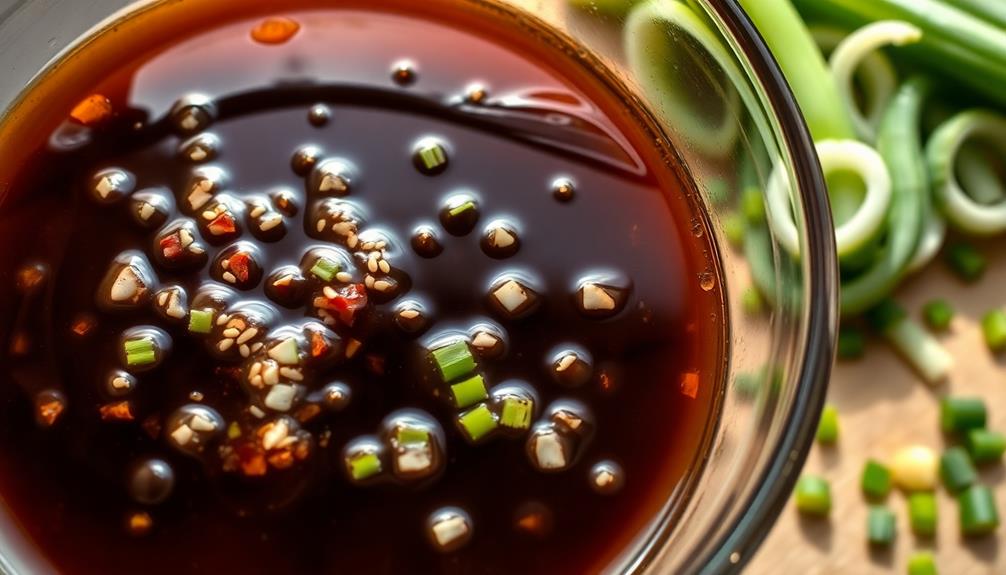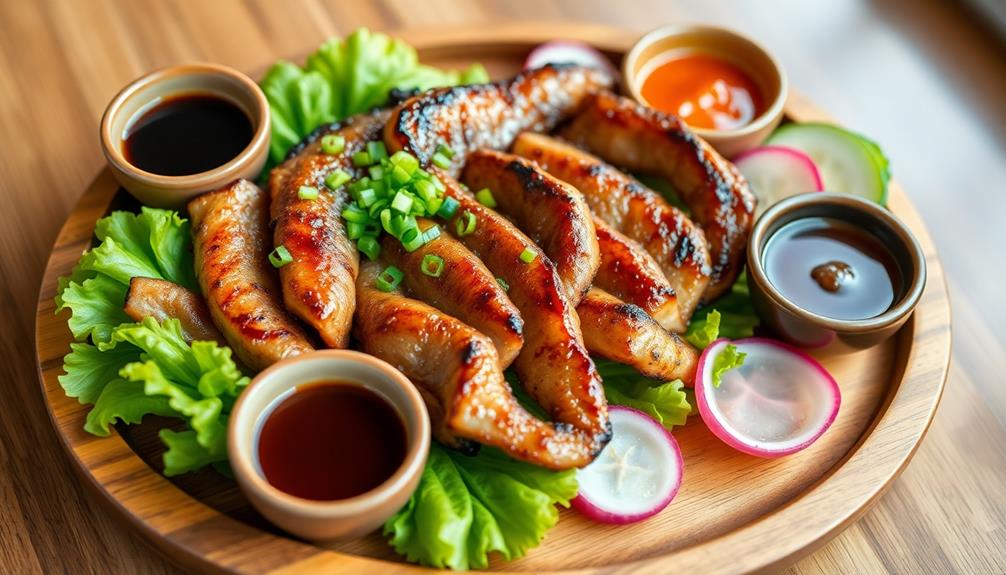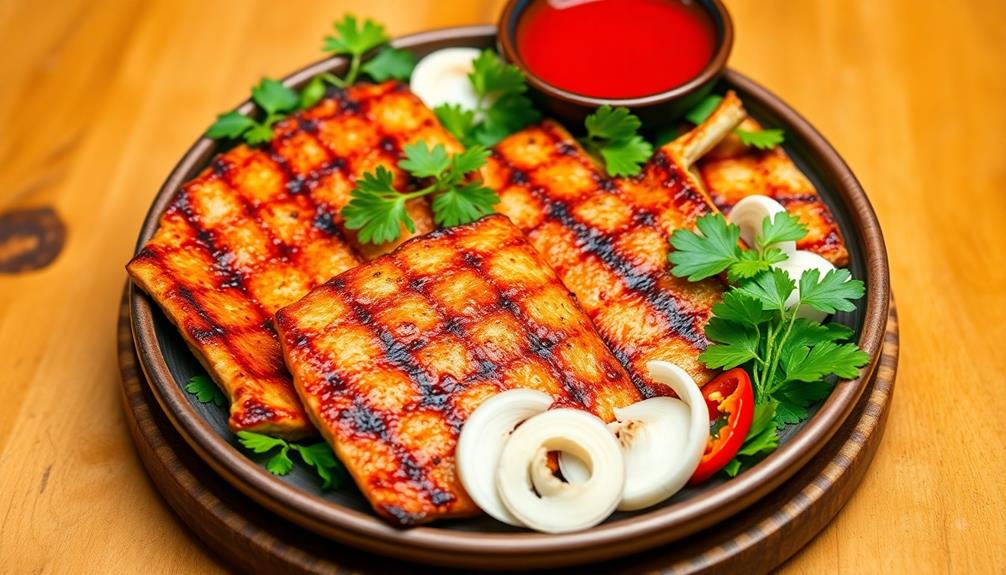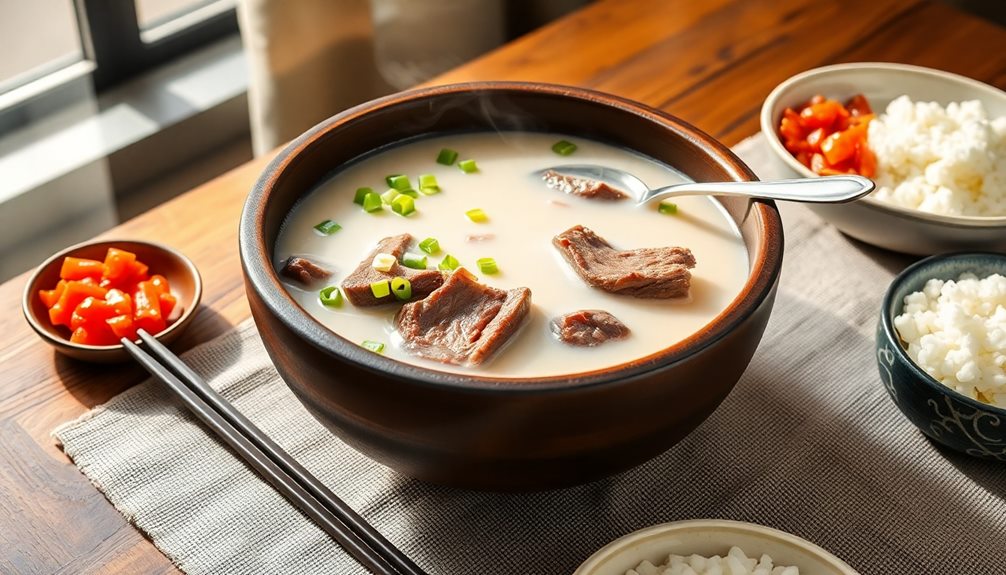Gopchang, or grilled intestines, is a tasty Korean dish that's loved for its chewy texture and rich flavor! You start by cleaning the intestines really well, then marinating them in a mix of soy sauce, sesame oil, and some spices. After marinating, you grill them for a few minutes until they're golden-brown and delicious. Pair your gopchang with a yummy dipping sauce made from soy sauce and sesame oil, and enjoy it with fresh veggies or rice. It's perfect for sharing with friends! Stick around, and you'll discover more fun facts and tips about this adventurous dish!
Key Takeaways
- Gopchang, meaning "intestines" in Korean, is a popular dish known for its rich flavor and chewy texture.
- The dish is made from beef intestines, marinated, and grilled to achieve a crispy exterior and tender interior.
- Commonly served with dipping sauces, gopchang pairs well with fresh vegetables and side dishes like pickled vegetables or rice.
- Its preparation involves thorough cleaning, marination, and grilling, making it a flavorful communal dining experience.
- Gopchang has historical roots in rural Korea, evolving into a beloved street food, especially in urban areas like Seoul.
History
While many cuisines around the world feature grilled meats, gopchang has carved out a unique niche in Korean culinary history. Gopchang, which means "intestines" in Korean, has been enjoyed for centuries. It's believed that people started grilling these tasty bits in the countryside, where farmers found them to be a delicious and affordable food source.
As time went on, gopchang became more popular, especially in bustling cities like Seoul. You might even say it turned into a star dish! People love it for its rich flavor and chewy texture, which makes every bite exciting. It's often enjoyed with friends, making it a fun and social meal.
Did you know that gopchang is often paired with spicy dipping sauces and fresh vegetables? This combination adds a burst of flavor that really makes your taste buds dance!
Plus, grilling the intestines gives them a crispy edge, making them even more delightful. So, the next time you hear about gopchang, remember it's more than just a dish; it's a part of Korean tradition, bringing people together over delicious food and happy conversations. Isn't that just wonderful?
Recipe
Gopchang, or grilled intestines, is a beloved dish in Korean cuisine known for its unique texture and rich flavor. This dish typically features the small or large intestines of cattle, which are cleaned thoroughly and marinated to enhance their taste. The grilling process gives the intestines a delightful char and smoky aroma, making it a popular choice for gatherings and barbecues.
When prepared correctly, gopchang can be a delicious and satisfying meal, often enjoyed with a variety of dipping sauces and side dishes. To create a memorable gopchang experience at home, you'll want to focus on the quality of the intestines and the marinade. A good marinade can elevate the natural flavors of the gopchang, while proper cleaning and grilling techniques ensure that the dish is both safe and delectable.
Pair it with some fresh vegetables and a cold beverage for a complete experience that captures the essence of Korean dining.
Ingredients:
- 1 pound gopchang (beef intestines)
- 3 tablespoons soy sauce
- 2 tablespoons sesame oil
- 1 tablespoon gochugaru (Korean red pepper flakes)
- 1 tablespoon minced garlic
- 1 tablespoon sugar
- 1 teaspoon black pepper
- 1 teaspoon salt
- Green onions for garnish
- Lettuce leaves for serving
To prepare gopchang, start by cleaning the intestines thoroughly under cold running water, ensuring you remove any residue. In a mixing bowl, combine the soy sauce, sesame oil, gochugaru, minced garlic, sugar, black pepper, and salt to create the marinade.
Add the cleaned gopchang to the marinade, ensuring they're well-coated. Allow the intestines to marinate for at least 30 minutes, or up to a few hours for a more intense flavor. Preheat your grill to medium-high heat, then grill the marinated gopchang for about 3-4 minutes on each side, or until they're nicely charred and cooked through. Serve with lettuce leaves and garnish with chopped green onions.
When cooking gopchang, it's essential to clean the intestines thoroughly to eliminate any strong odor. A common method is to rub them with salt and rinse well. Additionally, consider experimenting with different marinades to suit your taste; some people enjoy adding ingredients like ginger or vinegar for a kick.
Lastly, keep an eye on the grilling time, as overcooking can make the intestines tough. Enjoy the vibrant flavors and textures of this unique dish!
Cooking Steps
When you're ready to cook gopchang, the first step is to clean the intestines thoroughly, so they're nice and fresh.
Next, you'll marinate them with sesame oil, which adds a delicious flavor that'll make your taste buds dance!
Step 1. Clean the Intestines Thoroughly

Cleaning the intestines thoroughly is crucial for preparing gopchang, ensuring both safety and flavor. First, you'll want to rinse the intestines under cold water. This helps remove any dirt or gunk that might be hiding.
Next, grab some salt and sprinkle it inside. The salt acts like a scrubber, so work it into the intestines gently. Don't be shy; get your hands in there!
After that, rinse them out again until the water runs clear. If you have a little vinegar on hand, it's a great idea to use that too. Just a splash can help eliminate any strong odors. Remember, nobody wants smelly gopchang!
Now, take a closer look at the intestines to make sure there aren't any bits of fat or remnants left behind. If you spot any, cut them away carefully.
Once you've cleaned them well, you can pat them dry with a paper towel.
Congratulations! You've just cleaned your gopchang like a pro. Now, you're all set for the next exciting steps in your cooking adventure. Get ready to enjoy some delicious grilled intestines that are as safe as they're tasty!
Step 2. Marinate With Sesame Oil

Marinating the cleaned intestines in sesame oil infuses them with a rich, nutty flavor that elevates the dish.
First, grab a bowl and pour in a generous amount of sesame oil. You'll want enough to coat the intestines well, so don't be shy! Next, add a sprinkle of salt and a dash of pepper to enhance the taste. If you're feeling adventurous, toss in some minced garlic or ginger for extra zing.
Now, take the cleaned intestines and place them in the bowl. Make sure they're fully covered by the sesame oil mixture. Use your hands (don't worry, they're clean!) to massage the marinade into the intestines gently. This helps the flavors soak in better. Next, cover the bowl with plastic wrap and let the intestines marinate in the refrigerator for at least 24 hours. This step is crucial for allowing the flavors to fully develop. Once the marinating process is complete, your intestines will be ready to be used in your Korean marinated crab recipe.
Once you've coated them nicely, cover the bowl with plastic wrap and let it sit for at least 30 minutes. If you've got time, a couple of hours in the fridge works wonders!
This marinating step is super important because it allows the intestines to absorb that delicious sesame flavor. The anticipation will build, but trust me, it's worth the wait! Get ready for a tasty treat when you're done!
Step 3. Grill Over Medium Heat

Fire up your grill and get ready to cook those marinated intestines! Once your grill's nice and hot, it's time to set it to medium heat. This is super important because cooking at the right temperature helps to get that perfect balance of crispy on the outside and tender on the inside.
Now, carefully place the marinated gopchang on the grill. Make sure you give them a little space, so they don't stick together. Let them sizzle away for about 3 to 5 minutes on each side. You'll want to keep an eye on them, turning them occasionally to get an even cook. The smell will be amazing, and you might even find yourself drooling a little!
As they cook, watch for that lovely golden-brown color. It means you're on the right track! If you notice any flames, don't panic; just move the intestines to a cooler part of the grill.
Once they're beautifully grilled, it's time to take them off and let them rest for a minute. This way, the juices stay inside, making every bite delicious!
Step 4. Add Spices Before Grilling

Before grilling, you'll want to generously add spices to your gopchang for that extra burst of flavor. Spices are like the superheroes of cooking—they can turn something ordinary into something extraordinary! Start with a mix of salt, pepper, and garlic powder. These classics give your gopchang a tasty kick. Don't be shy! Sprinkle them all over, making sure every inch of those intestines gets covered.
Next, consider adding a dash of chili powder for a bit of heat, or some paprika for a smoky flavor. If you like to experiment, try a pinch of cumin or even some sesame seeds for a fun twist. Just remember, the key is balance; you want the spices to enhance the natural taste of the gopchang, not overpower it.
Once you've coated the gopchang with your chosen spices, let it sit for a few minutes. This allows the flavors to mingle and soak in, kind of like a party for your taste buds!
When you're done seasoning, you're ready to grill. With the right spices, your gopchang will be bursting with flavor, making every bite a delicious adventure! Happy grilling!
Step 5. Serve With Dipping Sauce

While the gopchang is grilling to perfection, it's the perfect time to prepare a delicious dipping sauce that will elevate your dish even further. You can make a simple yet tasty sauce using just a few ingredients. Start by mixing together soy sauce, a little bit of sesame oil, and a dash of vinegar in a small bowl. This combination gives the sauce a savory and tangy flavor that pairs beautifully with the grilled intestines.
Next, add some chopped green onions and minced garlic to the mixture. If you like a kick, sprinkle in some red pepper flakes or a tiny bit of gochugaru, which is Korean red pepper powder. Stir everything together until it's well combined, and voilà! You've got a fantastic dipping sauce ready to go.
Once the gopchang is done grilling, slice it into bite-sized pieces, and serve it hot alongside your dipping sauce. As you take that first bite, you'll be amazed at how the flavors come together.
It's a fun and tasty experience that'll have you coming back for more, so dig in and enjoy every delicious morsel!
Final Thoughts
Gopchang, with its unique texture and rich flavor, offers a culinary adventure that many food lovers cherish. If you haven't tried it yet, you're in for a treat!
This dish, made from grilled intestines, might sound unusual at first, but once you take a bite, you'll understand why it's so popular. The crispy outside and tender inside create a delightful combination that's hard to resist.
When you enjoy gopchang, don't forget to pair it with your favorite dipping sauce. This adds an extra burst of flavor that makes each bite even more exciting.
You can also try it with various side dishes, like pickled vegetables or rice, to balance the richness.
Frequently Asked Questions
What Are the Health Benefits of Eating Gopchang?
Eating certain foods can offer various health benefits. You might find that they provide essential nutrients, support digestion, and boost your immune system. Just remember to enjoy them in moderation for a balanced diet.
Where Can I Buy Gopchang in the US?
You can find gopchang at Korean grocery stores or specialized Asian markets in the US. Many Korean restaurants also serve it, so check local listings or apps to discover nearby places that offer this delicacy.
How Does Gopchang Compare to Other Grilled Meats?
When comparing grilled meats, you'll find that each has its unique flavor and texture. Gopchang offers a distinct richness and chewiness that sets it apart, making it a delightful choice for adventurous eaters.
Is Gopchang Suitable for People With Dietary Restrictions?
If you have dietary restrictions, you'll need to be cautious. Gopchang contains animal products, so it's not suitable for vegans or vegetarians. Always check for allergies or specific dietary needs before trying new foods.
What Are Popular Side Dishes to Serve With Gopchang?
When enjoying a delicious grilled dish, you can't go wrong with popular side dishes like kimchi, pickled radish, rice, or a refreshing salad. These options complement the main course and enhance your dining experience perfectly.









